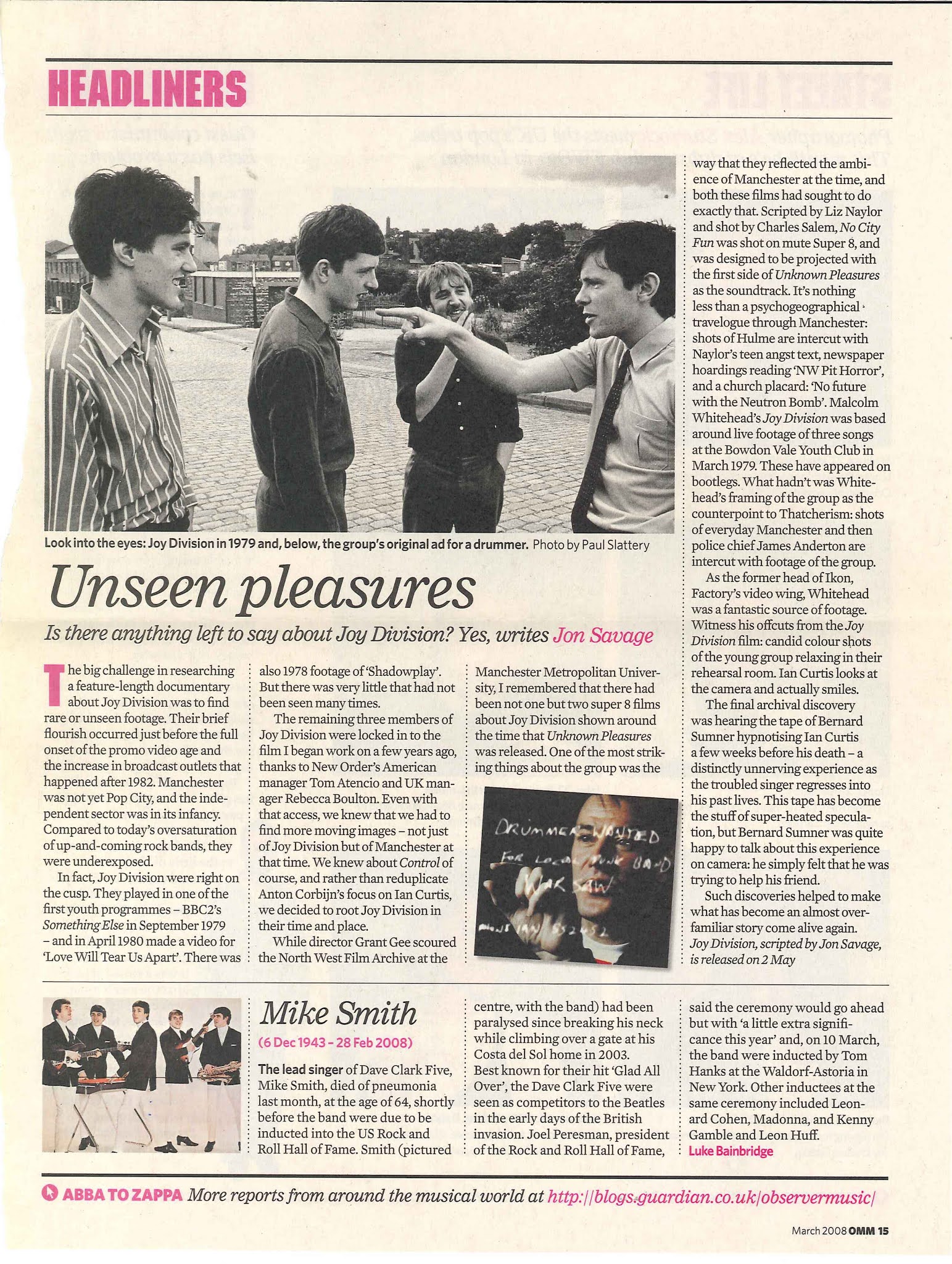2008 03 "Joy Division" Review Observer Music Magazine

https://www.theguardian.com/music/musicblog/2008/mar/16/unseenpleasures (slightly expanded text)
Unseen pleasures
Is there anything left to say about Joy Division? Yes writes Jon Savage
The big challenge in researching a feature-length documentary about Joy Division was to find rare or unseen footage. Their brief flourish occurred just before the full onset of the promo video age and the increase in broadcast outlets that happened after 1982. Manchester was not yet Pop City, and the independent sector was in its infancy. Compared to today's oversaturation of up-and-coming rock bands, they were underexposed.
In fact, Joy Division were right on the cusp. They played in one of the first youth programmes - BBC2's Something Else in September 1979 - and in April 1980 made a video for 'Love Will Tear Us Apart'. There was also 1978 footage of 'Shadowplay' (above). But there was very little that had not been seen many times.The remaining three members of Joy Division were locked in to the film I began work on a few years ago, thanks to New Order's American manager Tom Atencio and UK manager Rebecca Boulton. Even with that access, we knew that we had to find more moving images - not just of Joy Division but of Manchester at that time. We knew about Control of course, and rather than reduplicate Anton Corbijn's focus on Ian Curtis, we decided to root Joy Division in their time and place.
While director Grant Gee scoured the North West Film Archive at the Manchester Metropolitan University, I remembered that there had been not one but two super 8 films about Joy Division shown around the time that Unknown Pleasures was released. One of the most striking things about the group was the way that they reflected the ambience of Manchester at the time, and both these films had sought to do exactly that. Scripted by Liz Naylor and shot by Charles Salem, No City Fun was shot on mute Super 8, and was designed to be projected with the first side of Unknown Pleasures as the soundtrack. It's nothing less than a psychogeographical travelogue through Manchester: shots of Hulme and the city centre are intercut with Naylor's teen angst text, newspaper hoardings reading 'NW Pit Horror', and a church placard: 'No future with the Neutron Bomb'. Malcolm Whitehead's Joy Division was based around raw live footage of three songs at the Bowdon Vale Youth Club in March 1979 (see clip from YouTube above). These have appeared on bootlegs. What hadn't was Whitehead's framing of the group as the counterpoint to the onset of Thatcherism: shots of everyday Manchester and then police chief James Anderton are intercut with footage of the group live and in their rehearsal room.
As the former head of Ikon, Factory's video wing, Whitehead was a fantastic source of footage. Witness his offcuts from the Joy Division film: candid colour shots of the young group relaxing in their rehearsal room. Ian Curtis looks at the camera and actually smiles.
The final archival discovery was hearing the tape of Bernard Sumner hypnotising Ian Curtis a few weeks before his death - a distinctly unnerving experience as the troubled singer regresses into his past lives. This tape has become the stuff of super-heated speculation, but Bernard Sumner was quite happy to talk about this experience on camera: he simply felt that he was trying to help his friend.
Such discoveries helped to make what has become an almost over-familiar story come alive again.
Joy Division, scripted by Jon Savage, is released on 2 May.
Comments
Post a Comment